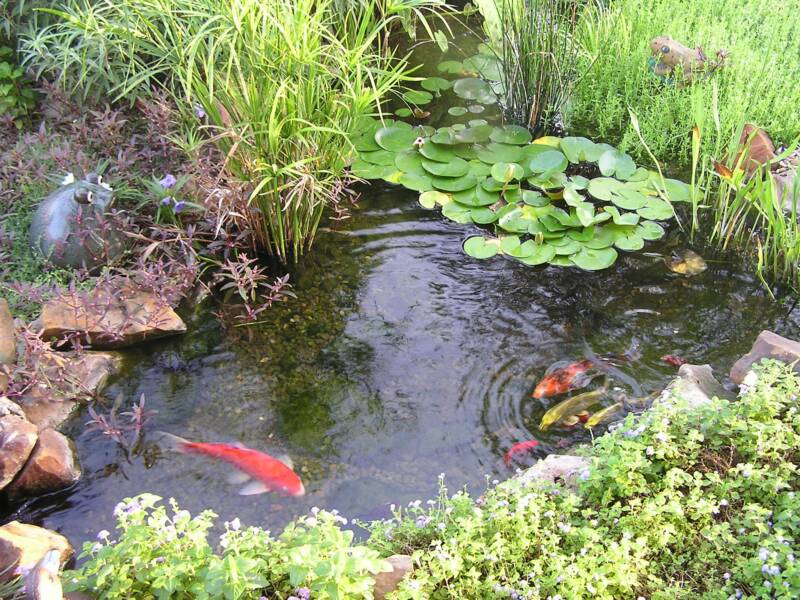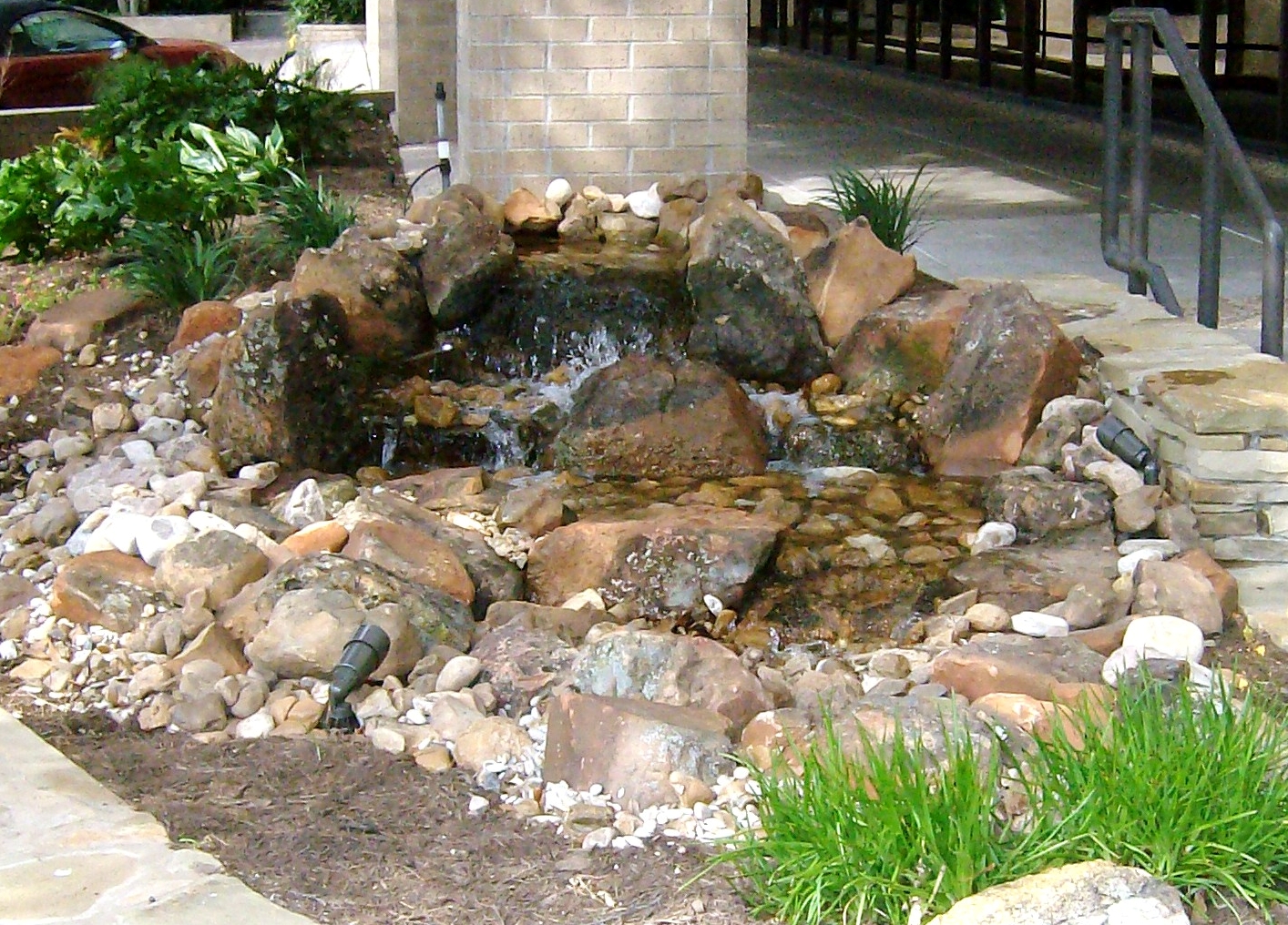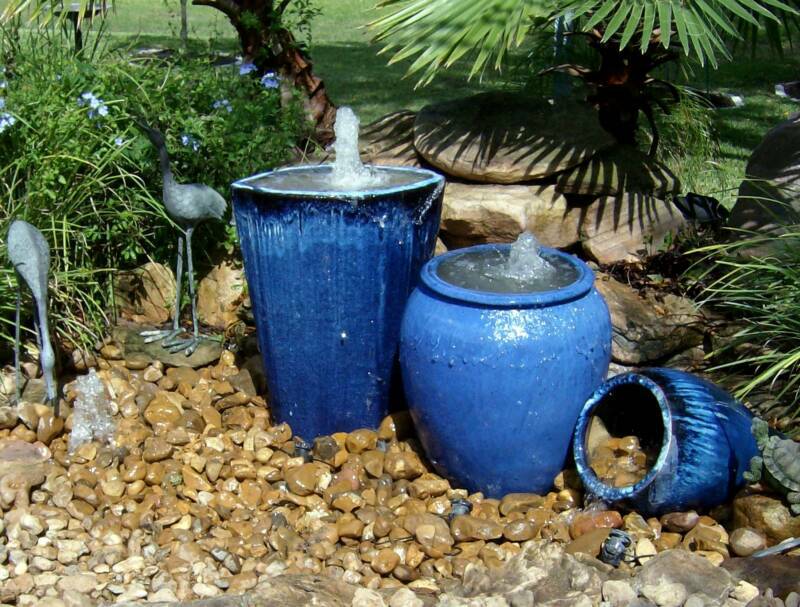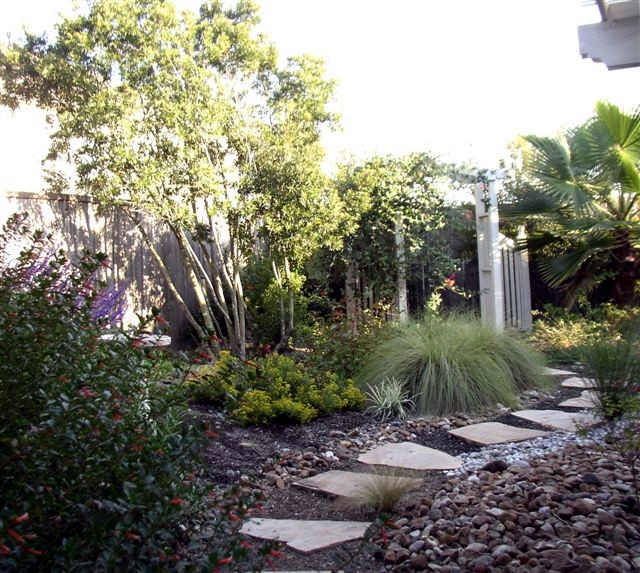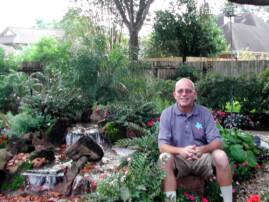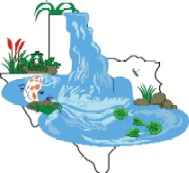


Rainwater Harvesting
Organic Ecosystem Ponds
Pondless Waterfalls
Urn and Fountain Features
Water-Wise Landscapes
Meet Your Water Feature Professionals


Texas Ponds and
Water Features
A Victorian Water Garden
by: Matt Boring
‘The Natural Water Gardener
There was a chill in the air that Monday morning in March with the mercury dipping just south of freezing before sunrise. Members of three different Texas pond-building companies were yawning and stretching their muscles while loading up their respective trucks and trailers for what was planned to be a large two-day pond build. John and Mark Cenicola, and John Garcia from ‘The Pond Crew’ in San Antonio, Steve Parker and Brandon Tucker from Alpine Aquascapes in Katy, and Matt Boring and Armando Sanchez from TexasPonds.com in Rosenberg showed up at the jobsite at roughly the same time to inspect the canvas on which they would try to quickly create a beautiful piece of the pond-builders’ art. The reason for the hurry was that this is peak work season for these companies and they had gathered here today to donate a couple of days worth of free labor to make something special happen for some special people who give much more than two days free labor each year in their community.
This story began for the pond-builders on the afternoon of January 29, 2007 when each of the three companies received a call from Pat Plowman of the Victoria County Master Gardeners Association. For Pat, the story had begun a couple of years before when a piece of land and a building that had long before been the Officer’s Club at historic Foster Airfield were donated to the Master Gardeners. They would use these accommodations to create a Community Education Garden to show interested citizens of the area examples of different kinds of plants and designs that do well in the area. The building and surrounding grounds would be used to host speakers and present educational seminars to coincide with the gardening theme.
All of Texas’ Master Gardeners Associations emphasize using native plants and organic gardening practices such as composting, and try to steer people away from invasive plants or non-native species that may beg for the use of herbicides, pesticides or extra water to survive in an area to which they’re not native. Master Gardeners are good stewards of the planet and they reach beyond what they do in their own homes and yards to try to educate others in the community about why they do what they do and live the way they live. Becoming a Master Gardener requires 50 hours of classroom work and 50 hours of community service with additional hours required each year after their certification. For this reason, Master Gardeners are some of the best-educated gardeners in their respective areas, with their knowledge far exceeding most others’, including professional landscapers, in those areas.
In front of the old officer’s club was a swimming pool that didn’t fit in with the new purpose of the property and provided a gaping hole where educational space might be. They decided that the swimming pool could somehow be converted into a large water garden. Since they wanted to promote organic practices even within their new water feature, they aimed their sights on putting together an ecosystem pond. Before leaving to pursue a business opportunity, a professional irrigator that had been working with the group told Pat about the Aquascape philosophy of pondering that said, “Work with Nature, not against her.” Knowing that a balanced aquatic ecosystem pretty much takes care of itself with just a little help from its human friends, Pat and the others decided that this was the best path to take. But how to get there from here?
Pat put on her thinking cap and set off on the information superhighway on her way to researching Aquascape, Inc. There she learned of the Certified Aquascape Contractor program, a group of professional pond-builders who have gone the extra mile to be the best of the best in their industry. Like the Master Gardeners, a Certified Aquascape Contractor must have classroom as well as hands-on training in the field. They must continue to receive training each year in order to keep their certification. Their work is reviewed by their peers and their customers are surveyed to make sure that only the companies who are tops in design and building techniques as well as tops in customer service are allowed to remain in the program. In fact, the program is so elite that a lesser-educated group of pond-builders who don’t subscribe to the organic philosophy by which all Aquascape water gardens are built has created a website to try to skim pond customers away by simply adding an ‘s’ to the real program’s web address! Using the ‘Find A CAC’ link on the website, Pat called the three closest companies and hoped that one of them would ride in to her rescue.
What she didn’t know was that these three contractors were all friends who had worked together in some capacity or other before this project came up. They were already on the phone to each other figuring out a way to work together on this project. They knew that the group wouldn’t have much money but everyone involved wanted to make sure this pond was done right and that these Master Gardeners were treated right. A couple of weeks later, John, Steve, and Matt made the trek to Victoria to meet with Pat and scope out the scene of the soon-to-be water garden.
The volunteers had already filled the swimming pool with dirt and dug the pond out, piling the dirt where they wanted the waterfall to be placed. They had the idea of a large bridge going across the middle of the pond to link two pathways together. Since that would block a good portion of the view that was being created, John suggested a land bridge across the same part of the pond. This is a feature that hides large culvert tubes in the pond and then seems to close up the ground above them so that you walk at pretty much existing ground level from one side of the pond to the other with the water and fish passing through the tubes below your feet. It’s a beautiful piece of the pond-builders’ art when it’s done correctly, effectively creating two separate ponds from one.
A water garden this large would need to be filtered by a constructed wetlands filter, sometimes referred to as a ‘bog filter’. Feeding the large waterfall and constructed wetlands filter would be two pumps housed in a ‘Grande’ skimmer. – That’s pronounced ‘GRAHN-day’ for you readers north of Dallas.– Since a skimmer that large isn’t the most easily-disguised feature, John decided to create an underground stream to a third pond that would hold the skimmer, rather than just sticking it on the side of the pond. This would effectively create what looks on the surface like another land bridge, opening up more views and allowing more human interaction with the water feature.
On the chilly morning of March 5, just five weeks after the initial phone calls were made, 7 people showed up ready to work hard. As they waited for the pond components to be delivered from the city property where it had been safely stored, the guys tweaked the initial excavation to create shelves within the pond. The hole for the skimmer had to be dug through asphalt, but was soon ready to go. Twenty five tons of rocks and fifteen yards of gravel were delivered right on shedule. Once the pond had the shape they wanted, a protective underlayment of fabric was laid down inside the empty shell and covered by a 45-mil EPDM liner.
Since all three companies build ponds by the same philosophy and have had similar training and experience, each team member was able to glide effortlessly between the many different little projects that make a big project like this come together. A couple of guys were installing the rocks along the vertical walls of the pond while a couple were bringing the rock to them with machines. When the machines were needed to help lift and install the larger boulders, other people worked on the land bridge or the underground stream. Before long the project had really begun to take shape. A local TV station showed up to cover the event. They took some video and took off. When they came back in the afternoon, they were so impressed by the amount of progress that they decided to put this report live on their evening newscast. The team members returned to a local motel to rest up for what promised to be another hard day that would start all too early the next morning.
The second day of the project wasn’t quite as cold and everyone wanted to get started getting finished. By the time lunch was served, it looked like things were on schedule. The Fire Marshall came by and was able to quickly fill the pond with a fire hose in about 45 minutes while the underwater lights were being installed and the finishing touches were being put on the waterfall. The constructed wetlands filter was finished and turned on first. Around 5:00pm, the waterfall sealing foam was dry and the second 7500 gph pump was plugged in.
As the waterfall flowed for the first time, a loud cheer went up from the assembled Master Gardeners. A cork was popped and the champagne flowed, with Dr. Pepper for the children. Flash bulbs began to twinkle and soon the three groups of Certified Aquascape Contractors had gathered around the waterfall for the familiar Aquascape’s ‘thumbs-up’ picture around their completed project. A little while later, with just enough adrenaline still in their systems to make the drives home, they each went back the way they came, heading off into, and away from, the approaching sunset. While Matt would return a few weeks later to install an automatic-fill valve and plant the aquatic plants, the pond-builders’ work here was done.
But not so for the Master Gardeners. With a grand opening date of May 20th looming large on the approaching horizon, stone pathways had to be completed, gazebos built, and a fence erected. Then, finally, last but certainly not least, landscaping will be installed. They have a landscape designer who is going to create a tropical-themed paradise around the new water garden. I have a feeling that a lot of those community service hours will have been earned by the day of the Grand Opening celebration. But the completed result will be an area the is beautiful, educational and enjoyable to all the people in Victoria county and the surrounding areas.
Victoria County Master Gardeners
www.vcmga.org
Victoria County Pond Project
www.vcmga.org/VEGWaterGardens.html
Pond Installation Pictures
www.photobucket.com search ‘VCMGA’
Certified Aquascape Contractors
www.certifiedaquascapecontractor.com
The Pond Crew
www.thepondcrew.com
Alpine Aquascapes
www.backyardcreations.org
Texas Ponds and Water Features
www.TexasPonds.com

